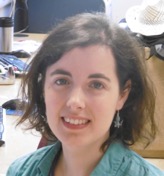Warwick Integrative Synthetic Biology Centre and School of Life Sciences, University of Warwick, Coventry , UK Translation initiation events on structured eukaryotic mRNAs generate gene expression noise Nucleic Acids Research, 2017, doi: 10.1093/nar/gkx430 Estelle Dacheux, Naglis Malys, Xiang Meng, Vinoy Ramachandran, Pedro Mendes & John EG McCarthy
Cv
Estelle Dacheux, 31 years old, studied Molecular and Cellular Biology at the University Montpellier II (Bachelor) and then at the University of Lyon I (Master), before doing a PhD at the Cancer Research Centre of Lyon under the supervision of Dr. Nicole Dalla Venezia. The object of this PhD thesis, obtained in 2013, was to study the involvement of the tumor suppressor protein BRCA1 in translational control and it allowed to identify potential BRCA1 translational targets in the MCF7 cell line. This led Estelle to get interested in post-transcriptional control mechanisms in Eukaryotes. Consequently, she joined Pr. John McCarthy’s lab as a post-doctoral researcher to study gene expression stochasticty generated at the translational level in the yeast Saccharomyces cerevisiae. The results of this study, published in Nucleic Acid Research, showed that stable secondary structures in the 5’UTR of mRNAs increase the « noise » generated at the translational level, contributing significantly to the overall gene expression noise. Now Estelle has joined the lab of Micheline Fromont-Racine at the Pasteur Institute in Paris to study the mechanisms leading to the degradation of aberrant mRNAs and their encoded peptides in Saccharomyces cerevisiae.
Contact
Dr Estelle Dacheux
Post-Doctoral Fellowship Researcher
Pr John McCarthy’s lab (M015, MRI building)
Warwick Integrative Synthetic Biology centre (WISB)
School of Life Sciences
University of Warwick
+44 (0)24 76 574242
http://www.wisb-uow.co.uk
Abstract
Gene expression stochasticity plays a major role in biology, creating non-genetic cellular individuality and influencing multiple processes, including differentiation and stress responses. We have addressed the lack of knowledge about posttranscriptional contributions to noise by determining cell-to-cell variations in the abundance of mRNA and reporter protein in yeast. Two types of structural element, a stem-loop and a poly(G) motif, not only inhibit translation initiation when inserted into an mRNA 5΄ untranslated region, but also generate noise. The noise-enhancing effect of the stem-loop structure also remains operational when combined with an upstream open reading frame. This has broad significance, since these elements are known to modulate the expression of a diversity of eukaryotic genes. Our findings suggest a mechanism for posttranscriptional noise generation that will contribute to understanding of the generally poor correlation between protein-level stochasticity and transcriptional bursting. We propose that posttranscriptional stochasticity can be linked to cycles of folding/unfolding of a stem-loop structure, or to interconversion between higher-order structural conformations of a G-rich motif, and have created a correspondingly configured computational model that generates fits to the experimental data. Stochastic events occurring during the ribosomal scanning process can therefore feature alongside transcriptional bursting as a source of noise.




